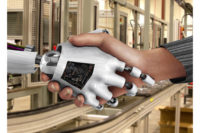Conveyors and forklifts have long been synonymous with assembly lines. But, in a lean world, those types of traditional material handling tools are often frowned upon. Some manufacturing engineers believe that automated guided vehicle (AGV) technology provides a better way to reduce waste and streamline production flow.
“In today’s environment, where lean manufacturing is nearly a requirement to survive, customers are demanding AGVs that are flexible, cost-effective and reliable,” says Keith Soderlund, vice president of sales at Creform Corp. (Greer, SC). “Many of our customers are buying an AGV system to suit today’s requirement, but demand the ability to reconfigure it for a future application. Fully supporting lean programs requires special consideration on all system designs and even what capital equipment is purchased.”
According to Soderlund, AGVs eliminate the human element of delivering parts to lean assembly lines, which results in consistent and reliable cycle times, and addresses error-proofing initiatives. “AGVs also lend themselves to small lot sizes, which ultimately is one-piece flow,” he explains.
In addition, Soderlund believes that AGVs can help manufacturers as they implement more mixed-model production processes. “One way they support this is by moving what was stored line-side to a supermarket picking area sometimes called the ‘set part system’ or ‘synchronized production system,’” he points out. “Employees assigned to kitting pull appropriate parts and place them on carts that are delivered to the assembly line via AGVs. Having custom-kitted parts on a cart makes assembly line operators more efficient. They get just the parts they need in the best possible position on the assembly line.
“Our customers are often changing their plants and their processes to adapt to changing markets,” claims Soderlund. “Inevitably, there are parts of their plant or pieces of equipment that can’t be changed. AGVs are often used to connect to or from these pieces of equipment.”
Soderlund says he sees a lot of companies using AGVs to transport parts and components that don’t contain conventional packaging, which saves time and space in the plant. “Our most sophisticated customers are actually doing automatic or semiautomatic transfers of parts between the AGV and off-board transfer stations,” he points out.
Concern over rising labor costs is also spurring more manufacturers to consider using AGVs for lean material handling applications. “Reducing labor costs (including hiring, training and absenteeism, in addition to the normal hourly labor costs), reducing product damage, and accurately tracking product movements are some of the most common benefits sought by our customers,” says Mark Longacre, marketing manager at JBT Corp (Chalfont, PA), which recently changed its named from FMC Technologies.
Traditionally, it’s been relatively easy for American manufacturers to not invest in automation and simply staff up and staff down as demand changes. “Automation would often be a more efficient long-term solution, but top-management compensation is more heavily based on short-term results,” notes Longacre.
However, a different mentality exists in Europe, where the AGV market has always been much stronger than in the United States. One reason why is because return-on-investment expectations are much higher on this side of the Atlantic Ocean. American companies expect a quick ROI-often less than two years and sometimes as low as nine months.
“This is a result of the expectations for short-term stock performance,” claims Longacre. “Management teams at European firms can be more patient to deliver returns over a longer period, such as five years or more. As European firms compete in global markets, however, they are beginning to look for quicker returns, as well.
“Labor laws in the U.S. allow firms to hire and release employees with relative ease,” adds Longacre. “In Europe, when hiring an employee, companies make a longer term commitment and pay a penalty if that position is eliminated. Because of those labor laws, European firms more carefully consider automation. There is often no alternative available that does not require a long-term commitment or investment.”
The Lean Side of AGVs
Looking for a reprint of this article?
From high-res PDFs to custom plaques, order your copy today!




